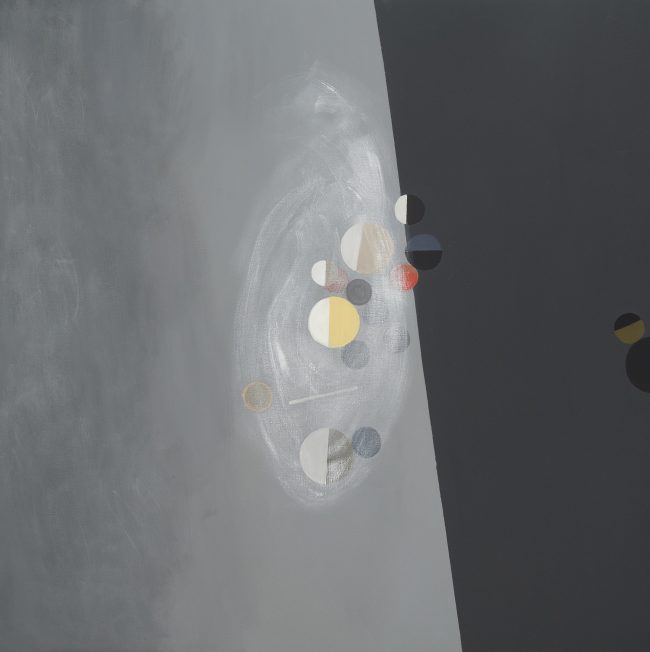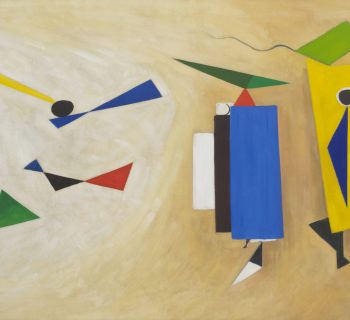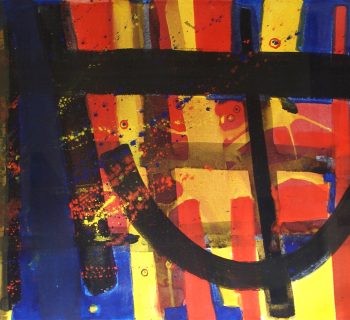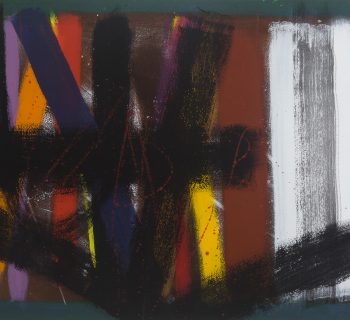Reminiscences

Wilhelmina Barns-Graham Through the Mist, Day/Night Series 1981 acrylic on canvas 126.8 x 126.8 cm BGT455 Exhibited Scottish Gallery 1981
Geoffrey Bertram – Reminiscences on Wilhelmina Barns-Graham
1981
I was fortunate enough to be employed at Aitken Dott & Son, the Edinburgh Fine Art Dealers, in the summer of 1981 when Wilhelmina Barns-Graham held the all-important Edinburgh Festival slot in the gallery’s exhibition programme. I was manager of the prints department, working with Scottish antiquarian and contemporary British prints, and assisted with installing the gallery’s exhibitions. Although Barns-Graham had shown her work there previously, this was her first solo show with the gallery since 1960.
W. Barns-Graham consisted of 79 works split into four sections – oil paintings (31), gouaches (14), drawings (8) and line drawings (26) – with the majority of works from 1978 to 1980 supplemented with a handful of paintings representing themes from the earlier 1970s. The exhibition opened on 14 August and ran until 5 September. Well received by visitors and exhibition reviewers, it helped reinforce Barns-Graham as a significant Scottish artist in Scotland. That the exhibition stood up well critically alongside two major Edinburgh Festival exhibitions on abstract painting held concurrently – American Abstract Expressionism and The Avant-Garde in Europe 1955-70 – was well noted.
The predominant themes of the exhibition’s paintings were the Expanding Forms Touch Point Series, Movement in Space and Progressive Movement Series. These series were having their very first outing and, although critically acclaimed, the paintings were a hard sell to Scottish art buyers who on the whole responded better to the Scottish Colourists and artists of the Edinburgh School. Indeed, of the first eighteen paintings listed in the catalogue, sixteen were bequeathed to Wilhelmina Barns-Graham Trust at the time of the artists’ death in 2004. Smaller works sold as did many of the drawings, particularly the multi-line energy drawings, but when it came to the major paintings, there was a distinct lack of support.
The Expanding Forms paintings and their related counterparts extended Barns-Graham’s explorations of form and movement, which evolved from the 1960s series Things of a Kind: Order and Disorder. Initially working with squares and circles, the waveforms, with their quasi-triangular aspect, extended the previous explorations. Observing the landscape inspired much of Barns-Graham’s art and it is easy to view these paintings as capturing the movement of waves breaking onto Porthmeor Beach, which her St Ives home overlooked. However, for Barns-Graham such observations were only a starting point, the experience becoming subsumed and re-imagined within her practice. The paintings are not so much about the waves on the shore but a broader interpretation into describing form and movement. This is also true for her energy line drawings. These meditative images describe the forces of nature, the actions of wind, earth and water. Their abstract patterning contrast strongly with the naturalistically rendered landscape drawings displayed alongside them.
1989
I left the Scottish Gallery not long after the 1981 exhibition opened but in 1988 I was invited back to take up the position of manager for the gallery’s new outpost in London. Incorporated as PLC in 1984, the gallery was taking advantage of the enthusiastic interest in Scottish art that had grown up through the 1980s. It set itself firmly in the centre of London’s art scene on Cork Street, one of the world’s most significant art gallery locations at that time. There I found Wilhelmina Barns-Graham to be one of six artists under contract. The gallery opened in early 1989 with an exhibition that reflected the diversity of the gallery’s activities, followed directly with New Paintings by W. Barns-Graham.
That Wilhelmina Barns-Graham was the gallery’s second exhibition acknowledged the importance of not only her position within contemporary Scottish art but, as the gallery considered, to London also. Comprising 20 acrylics and gouaches on paper, the exhibition revealed Barns-Graham to be re-exploring and re-imagining earlier themes, most notably Linked Forms, all carried out with considerable vigour and heightened colour. Her new attitude arose from her seeing the Late Picasso exhibition at Tate in 1988. She found this to be intensely stimulating, the energies within Picasso’s painting echoing her own feelings as an aging artist. Like Picasso, she loosened up her brushstrokes to become more expressive. The slim catalogue had an introduction written by Douglas Hall who cited that ‘The Art Wilhelmina Barns-Graham’s practises has been central to modern British Art for more than 40 years’ and that ‘Now in her seventies, Barns-Graham is one of the most senior and consistent British artists…..’
There was considerable diversity in the imagery, extending from connected forms to abstracted studies of jellyfish, seaweed and stones. The exhibition showed a marked shift in direction from the Expanding Forms et al seen at the start of the decade, characterised by a fluidity in her mark making that, in retrospective, was to become the new hallmark of her art, moving away from the harder edge pattern making for which she was known. In the art press there was a full article written about her by Linda Saunders in Modern Painters and a review from Mary Rose Beaumont in Art Review. However, there were no sales – a huge disappointment. Indeed, in 2004, the Wilhelmina Barns-Graham Trust inherited fifteen of the twenty paintings. Barns-Graham’s reputation was clearly at a low ebb and interest in her art negligible, a situation that the gallery had underestimated.
1992
My involvement with Wilhelmina Barns-Graham has always been due to her Scottish background and not the context of the St Ives Group. This is still true, with her Trust based in Scotland. So, when it came to Barns-Graham exhibiting with the Scottish Gallery in London there was never a St Ives context at the gallery for her to be seen within. The same was true of the William Jackson Gallery where, in 1992, she held her 80th birthday exhibition.
This was the first Barns-Graham exhibition that I was fully involved with, selecting the paintings and directing the exhibition. I received considerable assistance from Barns-Graham’s friend and business manager Rowan James, whose friendship was to be hugely significant to me in the future. It was decided that the exhibition would be a survey of Barns-Graham’s art from the 1960s onwards. John Russell Taylor, art critic of The Times, wrote a very perceptive introduction to the fully illustrated catalogue. The exhibition started with examples from early Things of a Kind: Order and Disorder before continuing with Expanding Forms, two 1980s glacier paintings and a selection of paintings on paper from her visits to Lanzarote. There were also new paintings that revealed the progress she had made from those seen in the 1989 show.
Unfortunately, this was not a good moment for the exhibition. The economy remained in recession. The art press was not interested; there were no reviews except a short piece by Russell Taylor in The Times. To make matters more difficult, in the second week, Francis Bacon died of a heart attack while on holiday in Madrid, which took all art press headlines. Only six of twenty-eight works in the show were sold. However, very positively, one of the sales was Passing Over Tribute Series (1982-86), purchased by the Government Art Collection. One other sale was to the late Sir Geoffrey Holland who owned Little Parc Owles in Carbis Bay, St Ives, the one-time home of Margaret Mellis and Adrian Stokes when Barns-Graham first arrived in Cornwall and later owned by Peter Lanyon. It was felt that the painting – The Garden (Balmungo) – had found an appropriate home. Holland with his wife Carol went on to establish the Little Parc Owles Trust in 2002, an arts charity that provides grants to organisations for their educational programmes, a mission similar to the Wilhelmina Barns-Graham Trust.
A particularly important outcome for this exhibition is that it travelled to museums and galleries around the UK, introducing Barns-Graham to many audiences who had not come across her work before. This was a crucial moment in her career as it was the first time that a Barns-Graham exhibition had toured and the response was overwhelmingly positive. It was seen at Lillie Art Gallery, Milngavie; Abbot Hall Art Gallery, Kendal; Royal Albert Memorial Museum, Exeter; Dundee Art Galleries & Museum, Dundee; Wakefield Art Gallery, Wakefield. The tour laid the foundation for the future upswing of her reputation.
1995
In late 1993 I helped to establish Art First, a new gallery in London’s Cork Street. It opened its doors for the first time in January 1994. One of the key artists I brought into the gallery stable was Wilhelmina Barns-Graham, persuaded by Rowan James that this was the right move despite the art market still being in the doldrums. We were all taking a chance. However, in such instance, one can hope that the only way is up.
The first Barns-Graham display was a selection of drawings held in August/September – W. Barns-Graham: Drawings 1945-60. This was not a major exhibition by any means but a statement of intent and commitment to represent her in our new venue. The first full painting show was held in November the following year.
W. Barns-Graham; New Paintings was comprised entirely of paintings on paper, the majority in gouache, the remainder acrylic. Working primarily on paper was liberating for Barns-Graham as it gave her the freedom to be spontaneous, getting things down quickly and where, if she made a mistake (which she rarely did!), it could be easily destroyed and another piece of paper reached for. For Barns-Graham, working on canvas was a more considered affair, the painting more consciously designed and worked on. Because she took this attitude, her later works on canvas often lack the fluidity found in her works on paper.
Thematically, this collection extended the expressive paintings first seen in W.Barns-Graham at 80. A new feature was the introduction of bars of colour applied with broad brush strokes, anticipating the Scorpio paintings that were to become the driving force behind the startling rise of her reputation shortly after. There is fluidity, zesty colour and a revitalised dynamic that captures the eye. While the Wind Series and Celebration paintings made a clear re-use of the Golden Section in their construction (a format she first applied in paintings from the 1950s) the Constellation paintings extended her use of the circle with a freer handling of the brush.
For the first exhibition in a gallery still finding its feet, the reception was good. Of twenty paintings shown, half found new homes – a significant improvement.
1997
The second Wilhelmina Barns-Graham painting exhibition at Art First opened on 13 May 1997. Wilhelmina Barns-Graham: New Paintings contained eighteen works, all acrylic on paper. This was the first full-on Scorpio Series exhibition.
The reception was overwhelming. Seventy five percent of the exhibition sold at the outset, an unprecedented event for her. Visitors to the exhibition, many unfamiliar with Wilhelmina Barns-Graham, were taken aback by the vitality of the paintings, and were even more so when informed, upon asking, that this was the work of an artist in her eighties.
Two points which strike me about this exhibition. First, the paintings were bought by people who knew little about her and none were collectors of Modern British art. The gallery was establishing an entirely new audience for Barns-Graham, directing her away from the established Modern British art scene that, up until now, collectors and critics considered her part. This effectively split her buyers, and therefore market, into two distinct groups – modern and contemporary. The ramifications of this remain felt today.
The second point is that the dynamic Scorpio paintings brought her back to the attention of the London art world, particularly her peers. Once word had spread about the success of the exhibition, it was visited by leading abstract artists of her generation – John Hoyland, Bert Irvin, Terry Frost, et al. She was immensely gratified by this. They were then all to be seen at the openings of her later shows.
In the exhibition catalogue David Brown (retired Assistant Curator in the Modern Collection at the Tate Gallery) wrote that he “….showed a group of 8 young Japanese museum curators around St Ives and introduced them to some of the senior artists. One of the high points was Willie and her studio where the visitors were enchanted. Everyone ended up siting on the floor and the Japanese demonstrating calligraphy and writing ideograms and Willie making her own versions of such writing. I’m sure some of the fruits of this visit are to be found in some of her pictures.” It is an interesting observation as in the paintings of her final decade the action of her brush, the quality of her mark, plays a central role in her art as never before. Along with her extraordinary use of colour, it shapes this late work.
The upsurge in Wilhelmina Barns-Graham’s reputation really began at this point. Future exhibitions at Art First in her lifetime (1999, 2001, 2003) consolidated her position as a significant artist. Her exhibition at Tate St Ives in 2000 further enhanced her reputation, introducing her back catalogue to leading art writers and art enthusiasts who professed a complete lack of awareness of its depth and quality. The rest, as they say, is history.

Wilhelmina Barns-Graham White Circle Red Square 1988 acrylic on paper 76 x 57.6 cm BGT519 Exhibited Scottish Gallery London 1989

Wilhelmina Barns-Graham Summer Painting No.2 1985 oil on canvas 91.3 x 121.4 cm BGT463 Exhibited William Jackson Gallery 1992

Wilhelmina Barns-Graham Fire Series No.3 1992 gouache on paper 56.8 x 76.3 cm BGT968 Exhibited Art First 1995

